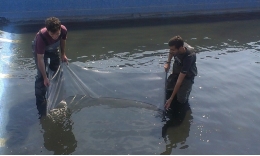Water quality and conservation of native species, essential in mosquito biocontrol
A new study carried out at the University of Barcelona analysed the efficiency in mosquito capture in two fish species: the mosquitofish (Gambusia holbrooki), an invasive species that arrived in Spain in 1921 to control malaria, and the Spanish toothcarp (Aphanius iberus), an endangered native species. The results show that turbidity caused by excessive algae, mainly due to the impact of the growing urbanization of territory and excessive fertilization, reduces the efficiency of mosquito capture in both studied species. According to the authors, these results strengthen the fact that it is necessary to keep a good quality of the water in continental water masses, including rivers, reservoirs, lakes and wet areas, to keep a biological control of mosquitoes.
The study, published in the journal Hydrobiologia, is signed by the experts Oriol Cano Rocabayera, Adolfo de Sostoa, Sergi Vargas and Alberto Maceda, from the Faculty of Biology and members of the Biodiversity Research Institute (IRBio) of the UB, and Carles Aranda, member of the Service of Mosquito Control of Consell Comarcal del Baix Llobregat.
Water excess harden the action of predators
The objective of the study was to analyse the efficiency in the mosquitofish’ and toothcarp’s mosquito capture, at different levels of water turbidity, caused by algae and clay. The results show that the increase of turbidity caused by accumulation of algae reduces, on average, the efficiency of both species by 32% compared to the inorganic turbidity and clear waters. “Excess of waters can significantly reduce the efficiency in both species’ mosquito capture, since both are visual predators. However, sediment and inorganic turbidity, shown in lagoons and delta systems, had a null impact, since these fish are adapted to the light features caused by this turbidity”, notes Oriol Cano.
These results show the importance of keeping the rivers in good state, as well as lakes, reservoirs and wet areas. “It is necessary to reduce the excess of nutrients and organic matter of anthropic origins in the continental water masses, since even low turbidity values, if this is caused by an excessive algal growths, can break the predator-prey interaction and harden the predator’s action in the biological control of mosquitoes”, highlights Oriol Cano.
Negative impact of mosquitofish
The study also compared the efficiency of the mosquitofish and the toothcarp: both species predated the larvae of the common house mosquito (Culex pipiens) differently. The mosquitofish showed a faster response towards the visual stimuli of the prey, and its voracity and consumption rate were higher in both laboratory tests and under semi-natural conditions. “However, in natural ecosystems we should consider other important factors that were not studied in here, such as populational effects (major or lesser fish density) and the interaction of both species with other potential mosquito predators”, notes the researcher.
Now, the introduction of exotic fish such as the mosquitofish is banned in many countries due to the negative collateral impacts (such as competency and predation) in fish, amphibians and invertebrates. In this sense, the authors highlight the need to prevent new introductions regardless of the mosquitofish in waters such as ponds, irrigation channels, and private ponds. Together with the urgent need to improve the state of water ecosystems, we also call the administrations to take in a reintroduction program of the toothcarp, economically funded in order to recover part of its natural distribution, which was lost in a matter of few decades”, concludes the researcher.
Article reference:
Cano-Rocabayera, O., Vargas-Amengual, S., Aranda, C. et al., L. 2020 “Mosquito larvae consumption in turbid waters: the role of the type of turbidity and the larval stage in native and invasive fish”. Hydrobiologia, 847, 1371–1381. Doi: https://doi.org/10.1007/s10750-020-04195-0
Source:PressUB
